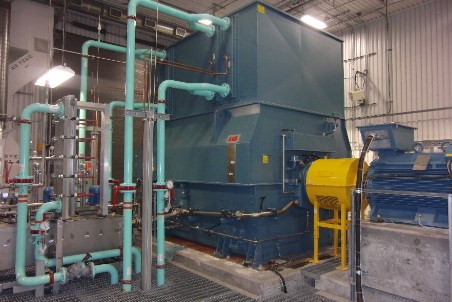Stabilising mining’s clean transition with synchronous condensers
Published by Jody Dodgson,
Editorial Assistant
Global Mining Review,

The global mining industry is experiencing one of the most significant transitions in its history. As companies move toward electrification and greater reliance on renewable energy, they are also confronting new challenges in maintaining power stability and reliability. This is especially the case at remote mine sites that often have weak grid connections or are entirely off-grid. While replacing diesel and coal-fired generation is essential for reducing emissions and improving efficiency, it has introduced new risks requiring swift, practical solutions.
As power grids evolve, the traditional sources of 'spinning inertia' – the vital kinetic energy reserve supplied by large fossil-fuelled generators are steadily disappearing. In mining, this means that when a generator shuts down unexpectedly or a fault occurs, there is less physical inertia to cushion disturbances and maintain frequency stability.
Declining short-circuit levels further weaken the grid. Related to that voltage dips caused by faults such as outages or line strikes can easily escalate to costly operational disruptions.
Furthermore, mining operations are increasingly adopting variable speed drives (VSDs) to improve motor control, process performance, and energy efficiency. Although VSDs contribute less to system inertia and fault current than traditional motor setups, this highlights the importance of complementary technologies such as synchronous condensers in maintaining network stability during the mining sector’s transition to cleaner energy systems.
The comeback of synchronous condensers
Against this fragile energy backdrop, synchronous condensers (SCs) are re-emerging as a proven tool for maintaining grid reliability. Historically used mainly for voltage control and reactive power support, modern SCs offer far more. They provide immediate physical inertia and short-circuit strength, even when upstream networks are weak or unstable.
At ABB, we are working with mining operators worldwide to deploy synchronous condenser solutions that close the emerging reliability and stability gaps. Many remote mines operate far from main grids or depend on weak interconnections. Resultant power instability and outages not only threaten production but can compromise worker safety, damage equipment, and spoil ore.
Synchronous condensers stand out for their predictability and mechanical strength in such settings. Unlike battery storage or inverter-based systems, which can struggle to replicate the physical inertia of spinning machinery, they deliver true rotating mass that immediately stabilises network disturbances. Their high fault current capability also supports dependable circuit breaker operation and helps maintain power quality, even in weak or rapidly changing grid conditions.
Every mining operation presents different technical and environmental challenges. From isolated desert locations to subarctic regions, achieving grid stability requires careful, site-specific design. Our experience shows that incorporating synchronous condensers early yields the smoothest and most cost-effective outcomes. This proactive approach helps avoid costly, reactive retrofits and ensures that mines can expand their use of renewables without encountering unexpected reliability challenges.
Practical recommendations for operators
Based on lessons from the field and recent research, several steps can help enhance grid resilience in mining operations:
- Assess grid inertia and fault levels regularly: Continuous modelling of network characteristics helps identify vulnerabilities before they impact performance.
- Encourage collaboration and knowledge sharing: Engaging with suppliers and peers fosters innovation and helps mines learn from others’ operational successes.
- Design for flexibility: As ore processing and demand evolve, flexible grid support, such as synchronous condensers, supports adaptation without compromising stability.
- Value long-term reliability: When evaluating renewable investments, consider not only capital costs but also the operational benefits of grid-forming technologies in risk mitigation and production uptime.
Looking ahead
Mining’s electrification and decarbonisation are central to its future competitiveness and long-term sustainability. As these transitions progress, maintaining robust and resilient power systems becomes an operational imperative. Synchronous condensers have proven to be a cost-effective and dependable solution to mining’s grid challenges, providing the technical stability operators need.
Sustained collaboration across the mining value chain, combined with practical technology deployment, will ensure that power networks remain reliable, efficient, and prepared for the demands of tomorrow.
For more information, refer to ABB’s new whitepaper on synchronous condensers.
Read the article online at: https://www.globalminingreview.com/mining/29102025/stabilising-minings-clean-transition-with-synchronous-condensers/
You might also like
Teck and Anglo American receive Government of Canada approval for merger of equals under Investment Canada Act
Teck Resources Limited and Anglo American plc have received regulatory approval from the Government of Canada under the Investment Canada Act for the merger of equals between Anglo American and Teck which was announced on 9 September 2025.


